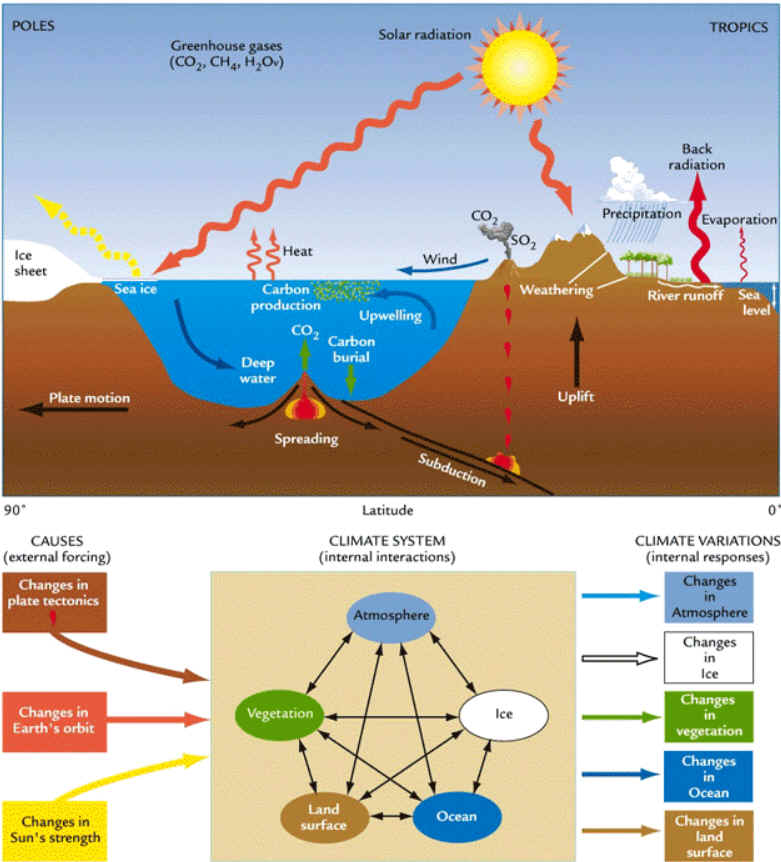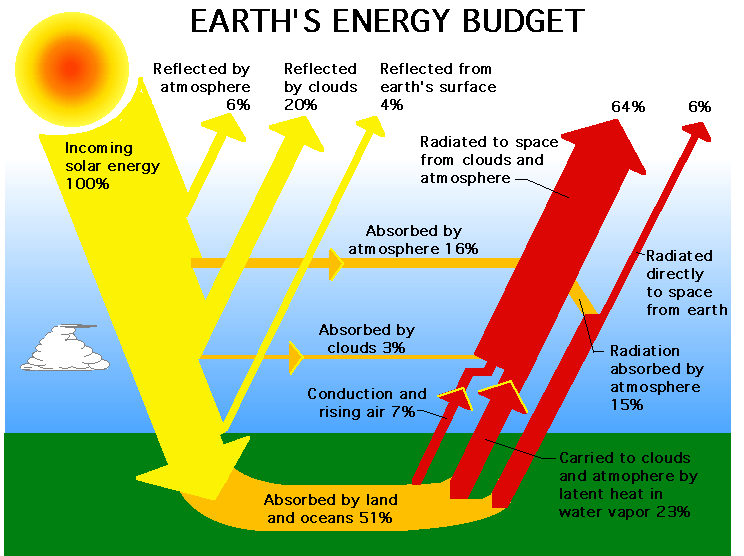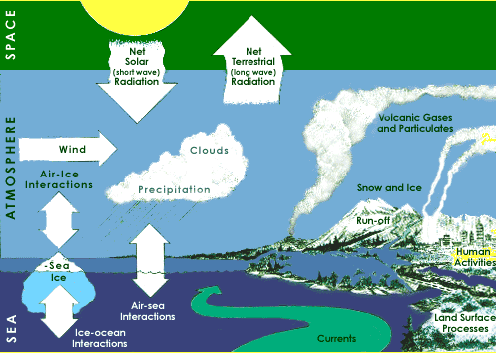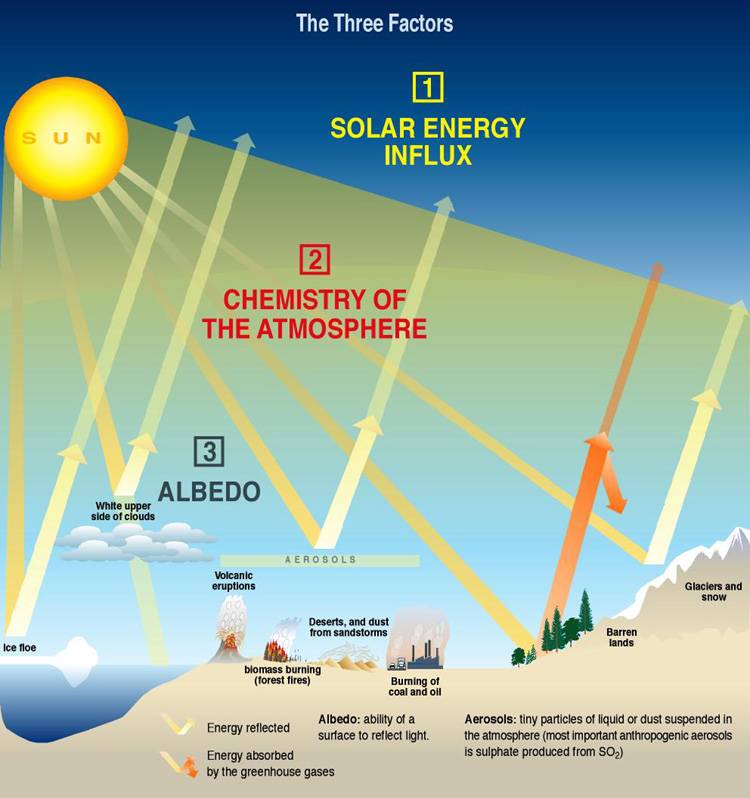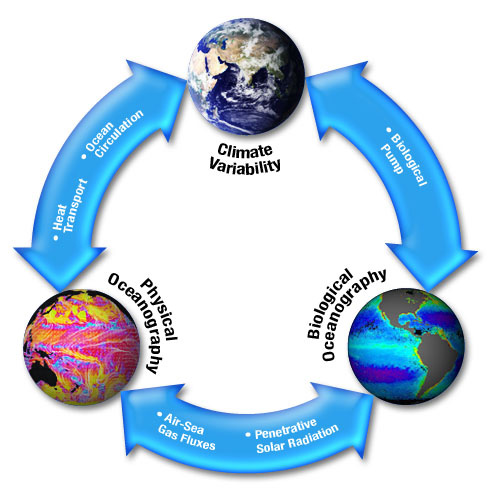
|
||||||||||||
|
|
|
Earth's Climate System
Energy from the sun drives the earth’s weather and climate, and heats the earth’s surface; in turn, the earth radiates energy back into space. Atmospheric greenhouse gases (water vapor, carbon dioxide, and other gases) trap some of the outgoing energy, retaining heat somewhat like the glass panels of a greenhouse.
Credit:NASA
Energy from the Sun reaching the Earth drives almost every known physical and biological cycle in the Earth system. The energy that keeps the earth's surface warm originates from the sun. The primary source of energy to drive our global climate system (including atmospheric and, to a lesser extent, oceanic circulation) is the heat we receive from the Sun, termed solar insolation. The amount of insolation which reaches the Earth's surface depends on site latitude and season. The insolation into a surface is largest when the surface directly faces the Sun. As the angle increases between the direction normal to the surface and the direction of the rays of sunlight, the insolation is reduced in proportion to the cosine of the angle. This is known in optics as Lambert's cosine law. This 'projection effect' is the main reason why the polar regions are much colder than equatorial regions on Earth. On an annual average the poles receive less insolation than does the equator, because at the poles the Earth's surface is angled away from the Sun.
Government of Canada Graphic
Although the energy that is emitted from the sun is almost constant, even small changes can have noticeable effects. When the Sun's energy reaches the Earth it is partially absorbed in different parts of the climate system. The absorbed energy is converted back to heat, which causes the Earth to warm up
There are three main factors that directly influence the energy balance of the earth and it's temperature:
Solar Variability: Striking a Balance with Climate Change NASA Video
The Earth's climate system is a compilation of the following components and their interactions-
The Earth has periods of time when the temperature rises (warming cycles) and periods when the temperature drops (cooling cycles) it is a series of natural cycles of our planet. The Sun and it's level of solar activity has an major influence on these cycles.
Today climate change and global warming are receiving unprecedented attention due to the possibility that human activity on Earth during the past couple hundred years will lead to significantly large and rapid changes in environmental conditions.
The first step in addressing the issue of global warming is to recognize that the warming pattern, if it continues, will probably not be uniform. The term "global warming" only tells part of the story; our attention should be focuses on "global climate change." The real threat may not be the gradual rise in global temperature and sea level, but the redistribution of heat over the Earth's surface. Some spots will warm, while others will cool; these changes, and the accompanying shifts in rainfall patterns, could relocate agricultural regions across the planet. Climate Variability The first step in addressing the issue of global warming is to recognize that the warming pattern, if it continues, will probably not be uniform. The term "global warming" only tells part of the story; our attention should be focuses on "global climate change." The real threat may not be the gradual rise in global temperature and sea level, but the redistribution of heat over the Earth's surface. Some spots will warm, while others will cool; these changes, and the accompanying shifts in rainfall patterns, could relocate agricultural regions across the planet. The ocean is a significant influence on Earth's weather and climate. The ocean covers 70% of the global surface. This great reservoir continuously exchanges heat, moisture, and carbon with the atmosphere, driving our weather patterns and influencing the slow, subtle changes in our climate. The oceans influence climate by absorbing solar radiationand releasing heat needed to drive the atmospheric circulation, by releasing aerosols that influence cloud cover, by emitting most of the water that falls on land as rain, by absorbing carbon dioxide from the atmosphere and storing it for years to millions of years. The oceans absorb much of the solar energy that reaches earth, and thanks to the high heat capacity of water, the oceans can slowly release heat over many months or years. The oceans store more heat in the uppermost 3 meters (10 feet) that the entire atmosphere, the key to understanding global climate change is inextricably linked to the ocean. Climate is influenced by storage of heat and CARBON DIOXIDE in the ocean, which depends on both physical and biological processes. Let's look at some of these processes. At the end of the last ice age, about 15,000 years ago, and the ice sheets melted away and climate warmed at that time. Ice sheets began to grow, and climate cool about 130,000 years ago at the beginning of the last ice age. About 130,000 years ago, fed by evaporation of ocean waters, the polar ice caps thickened and expanded Earth cooled by almost 12° C and global sea level to drop 130m below its current level. About 15,000 years ago, this process was reversed as more sunlight reached areas near the Arctic Circle, and Earth emerged from the ice age. Earth is about 8° Celsius (14° Fahrenheit) warmer today than it was then. Still recovering from the ice age, global sea level continues to rise. The past century alone has seen global temperature increase by 0.6 degree Celsius (1 degree Fahrenheit), and the average global sea level over the past decade has risen steadily. Is this just part of the natural cycle? How much of this warming is due to the burning of fossil fuels? Is human nature affecting Mother Nature? What should we do? Our response to the challenge of global warming begins by formulating the right set of questions.
Climate is effected by both the biological and physical processes of the oceans. In addition, physical and biological processes affect each other creating a complex system.
Credit: NASA, USGS, NOAA |
